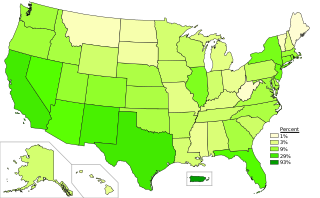
Back اللغة الإسبانية في الولايات المتحدة Arabic Idioma español n'Estaos Xuníos AST Spanisch in den Vereinigten Staaten German Ισπανική γλώσσα στις ΗΠΑ Greek Idioma español en Estados Unidos Spanish Espagnol des États-Unis French Castelán nos Estados Unidos de América Galician ספרדית בארצות הברית HE Az Amerikai Egyesült Államok spanyol nyelvhasználata Hungarian Lingua spagnola negli Stati Uniti d'America Italian
| United States Spanish | |
|---|---|
| US Spanish | |
| Español estadounidense | |
| Pronunciation | [espaˈɲol estaðowniˈðense] |
| Native to | United States |
| Speakers | 42 million (2022)[1] |
Early forms | |
| Latin (Spanish alphabet) | |
| Official status | |
| Regulated by | North American Academy of the Spanish Language |
| Language codes | |
| ISO 639-1 | es |
| ISO 639-2 | spa[2] |
| ISO 639-3 | – |
| Glottolog | None |
| IETF | es-US |
 Percentage of the U.S. population aged 5 and over who speak the Spanish language at home in 2019, by states. | |
| Part of a series on |
| Hispanic and Latino Americans |
|---|
Spanish is the second most spoken language in the United States. Over 42 million people aged five or older speak Spanish at home.[1] Spanish is also the most learned language other than English,[3] with about 8 million students. Estimates count up to 57 million native speakers, heritage language speakers, and second-language speakers.[4][5][6] There is an Academy of the Spanish Language located in the United States as well.[7]
In the United States there are more speakers of Spanish than speakers of French, German, Italian, Portuguese, Hawaiian, the various varieties of Chinese, the Indo-Aryan languages, and the Native American languages combined. According to the 2022 American Community Survey conducted by the US Census Bureau, Spanish is spoken at home by 42 million people aged five or older, more than twice as many as in 1990.[1]
Spanish has been spoken in what is now the United States since the 15th century, with the arrival of Spanish colonization in North America. Colonizers settled in areas that would later become Florida, Texas, Colorado, New Mexico, Arizona, Nevada, and California as well as in what is now the Commonwealth of Puerto Rico. The Spanish explorers explored areas of 42 of the future US states leaving behind a varying range of Hispanic legacy in North America. Western regions of the Louisiana Territory were also under Spanish rule between 1763 and 1800, after the French and Indian War, which further extended Spanish influences throughout what is now the United States.
After the incorporation of those areas into the United States in the first half of the 19th century, Spanish was later reinforced in the country by the acquisition of Puerto Rico in 1898. Waves of immigration from Mexico, Cuba, Venezuela, El Salvador, and elsewhere in Latin America have strengthened the prominence of Spanish in the country. Today, Hispanics are one of the fastest growing ethnic groups in the United States, which has increased the use and importance of Spanish in the United States. However, there is a marked decline in the use of Spanish among Hispanics in America, declining from 78% in 2006 to 73% in 2015, with the trend accelerating as Hispanics undergo language shift to English.[8]
- ^ a b c "Explore Census Data".
- ^ "ISO 639-2 Language Code search". Library of Congress. Retrieved 22 June 2019.
- ^ "US has more Spanish speakers than Spain". theguardian.com. Retrieved 2016-05-09.
- ^ Instituto Cervantes' Yearbook 2022. 15 million Spanish speakers as a second language or limited competence, and 8 million sutdents. (PDF). Retrieved on 20231
- ^ "Más 'speak spanish' que en España". Retrieved 2007-10-06. (Spanish)
- ^ Romero, Simon., Spanish Thrives in the U.S. Despite an English-Only Drive, New York Times, 23 August 2017. Retrieved 17 July 2022.
- ^ "Academia Norteamericana de la Lengua Española". Retrieved July 13, 2018.
- ^ "Spanish speaking declines for Hispanics in U.S. Metro areas".
© MMXXIII Rich X Search. We shall prevail. All rights reserved. Rich X Search